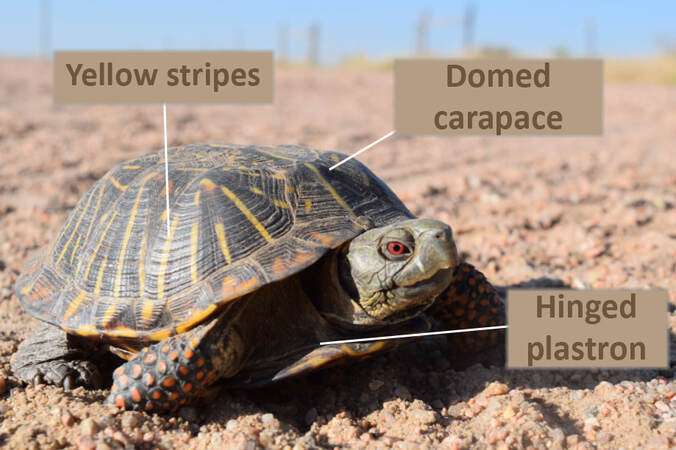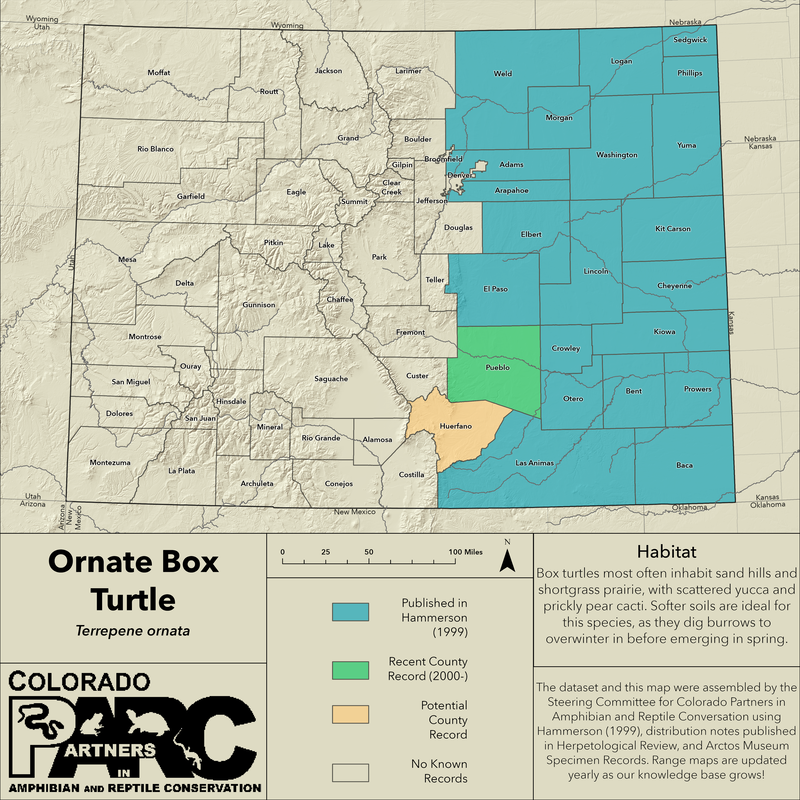|
Identification:
Distribution: Ornate box turtles are found through the plains of Eastern Colorado, at elevations under 5,500ft (1,680m). There are records of them appearing in Denver and Pueblo, but these are likely instances where box turtles are introduced and are not yet established. (Hammerson 1999)
Activity: Box turtles typically emerge in April and stay active until October. They are active during the day and tend to be more active on days that take place after a good rain. This is thought to be why they emerge in the spring. (Hammerson 1999)
Conservation Status: Ornate Box Turtles are considered near threatened throughout most of their native range. The collection of this species for the pet trade has caused some populations to decline dramatically, that and roadside mortalities could eventually lead to their status being changed to threatened. (Hammerson 1999)
NatureServe rank: G5 (Globally Secure), S5 (State Secure). (NatureServe ranking listed as "needs review") |
Habitat: Box turtles most often inhabit sand hills and shortgrass prairie, with scattered yucca and prickly pear cacti. Softer soils are ideal for this species, as they dig burrows, or use burrows create by other animals, to overwinter in before emerging in the spring. (Hammerson 1999; Stebbin 2003)
Diet: Ornate box turtles primarily prey upon insects, but will occasionally be found feeding on the carcasses of horned lizards, rodents, and even other box turtles. They have also been observed to consume spadefoot toad tadpoles, and young, ground nesting birds and their eggs. These turtles will also often consume plant material, primarily consisting of fruits. (Hammerson 1999)
Defense: The box turtle’s primary defensive response consists of withdrawing into their shell and closing it tightly, making it very difficult for any predators to prey upon them. (Hammerson 1999)
Natural Predators: While there are few recorded observations of box turtles being successfully preyed upon, it is thought that medium and large sized mammals, as well as predatory birds, would attempt to make a meal out of them. In addition it is possible that snakes could attempt to consume hatchling box turtles. (Hammerson 1999)
|
Cited & Additional Resources
Hammerson G. A. 1999. Amphibians and Reptiles in Colorado. University Press Colorado, Boulder.
Stebbins R. C. 2003. Peterson's Field Guide: Western Reptiles and Amphibians
Hammerson G. A. 1999. Amphibians and Reptiles in Colorado. University Press Colorado, Boulder.
Stebbins R. C. 2003. Peterson's Field Guide: Western Reptiles and Amphibians
Account compiled by: Rémi Pattyn
Reviewed by:
Last Updated: 12/11/2022 by Anthony Berardi
Reviewed by:
Last Updated: 12/11/2022 by Anthony Berardi



